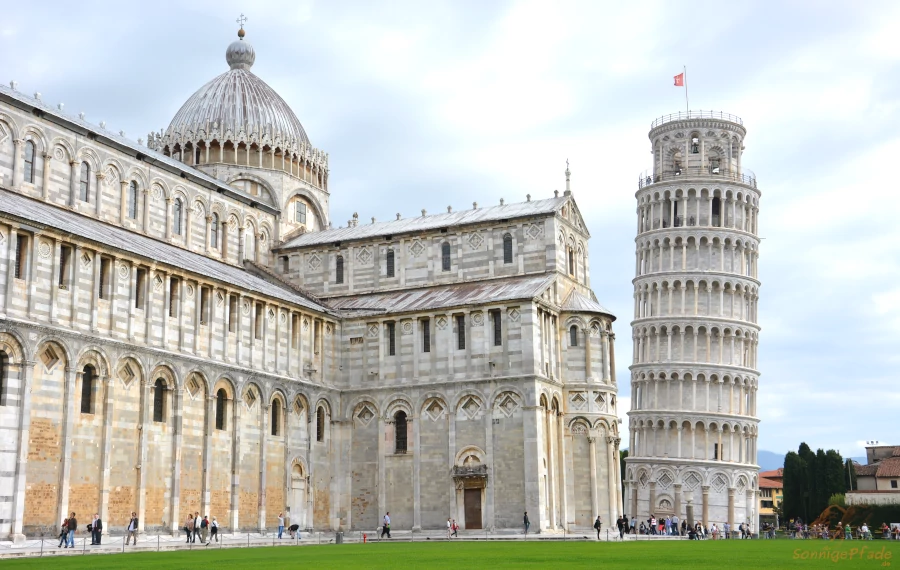
Actually, in German it is always said that crooked is English and therefore modern… In the italian city of Pisa crooked has probably an almost thousand-year-old tradition. The famous Leaning Tower of Pisa is there at the very beginning, but also with the city development probably some things have not gone so straight – to the chagrin of the Pisans and to the triumph of Florence.
The leaning tower of Pisa – landmark with unintentional fame
Apart from a few startled German education ministers, for whom the word Pisa regularly brings beads of sweat to their panic-stricken foreheads (because of a international education test for pupils, called “PISA”), all other inhabitants of the world immediately think of the leaning tower. It has had long enough to acquire this fame. The construction of the Pisa tower began as early as 1173 and twelve years later, when it had just reached the fourth floor, the inclination was already visible. The incomplete completion of the tower took almost 200 years due to interruptions in construction and it turned out to be a significant number smaller. Instead of 100m height, the Leaning Tower is only 56m high – but already with 3.60m deviation from the vertical!
This is world class – and attracts thousands of tourists every year to the small central Italian city on the Arno. And they also make fun of it. Most push or hold the tower, posing for a quick cell phone photo, with a smile on their face and despite their water-soup-thin figure. Some risk head and neck for the crooked tower – picture.
The Pisans even knew to wrest something good from the whole. After all, the scholar Galileo Galilei, a native of Pisa, is said to have discovered the laws of falling from the Leaning Tower. And the marketing of the strange building probably brings Pisa a good part of the annual income. That’s what I call sustainable tourism promotion!
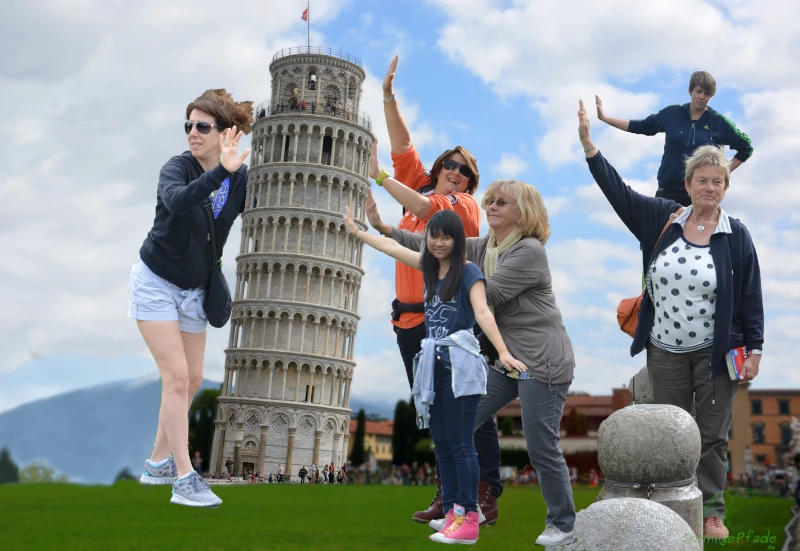
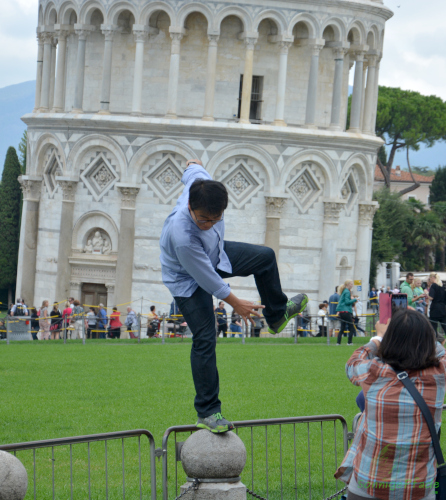
The Square of Miracles – Pisa’s Piazza dei Miracoli
The Leaning Tower, the Torre pendente, can be found in the northwest of Pisa’s Santa Maria district. At the Piazza dei Miracoli, the square of the miracles. Actually, it is simply called Piazza del Duomo, Cathedral Square. But hardly any Pisan speaks of it, and certainly no visitor. The most important sights of Pisa are gathered at this Piazza dei Miracoli – besides the Torre pendente also the Duomo (Cathedral of Santa Maria Assunta), the Baptistery (Battistero di San Giovanni), the Camposanto Monumentale, the Cathedral Museum and the Museo delle Sinopie.
Well, and other small attractions such as the column with the suckling wolf Lupa Capitolina, another chapel, sculptures, city walls and gates and lots of onlookers. These mostly with a somewhat pity – amused smirk “How can you build such a funny leaning tower“, but that lifts the general mood. Actually, the question should be “How do you manage that such a leaning tower has not fallen down for over 600 years?” – that demands some respect! So, naming the square of wonders in this way has its justification.

Whole Ensemble in marble
Besides the Leaning Tower, the Cathedral of Pisa is a very beautiful building. To the west of the cathedral still stands the Baptistry. Behind the square, as a northern section, the Camposanto Monumentale, a cemetery complex with an enclosed rectangular courtyard. In general, the whole ensemble in the cathedral square is worth seeing. The best time to visit is when the weather is sunny and the sky is blue, then the many white marbles look very animated.
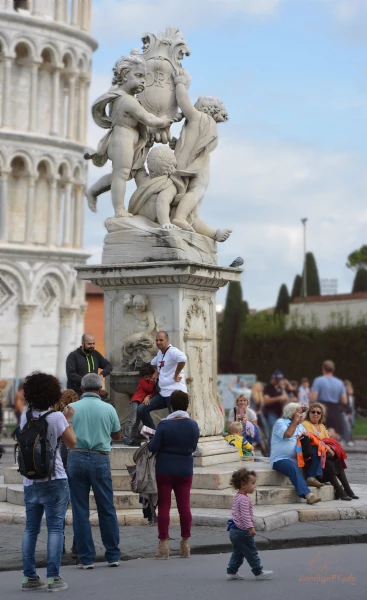
The contrasting green meadow areas, cordoned off with chains and concentrating the streams of visitors on wide marble slab paths, give the square a spacious and sublime appearance. Here someone has obviously thought about the best ensemble – effect. In general, the marble used from the region is impressive, both in its own coloring with fine color lines and shades, and in the workmanship. The Baptistery, Cathedral and Leaning Tower are beautiful buildings that testify to great design achievements and high craftsmanship of the builders. For the Leaning Tower alone, 14,200 tons of white Cararra marble were used. Since 1987, the entire ensemble in Piazza dei Miracoli with the Baptistery, Cathedral and Leaning Tower has been a UNESCO World Heritage Site.
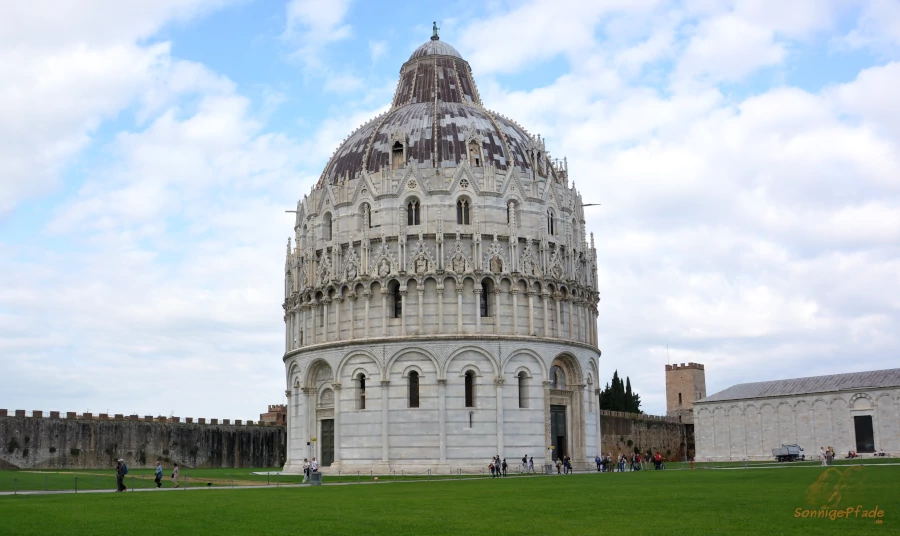
A bell tower for the Cathedral of Pisa
The Leaning Tower belongs to the Cathedral of Santa Maria Assunta, even if it is in an unusual place for it. For it is the bell tower to the cathedral. The design of the Leaning Tower is also unique for a “campanile“. While most of these bell towers were built with a square base and a pointed hipped roof, the Leaning Tower is a cylinder. The entrance floor is a closed round with a column framed round arch – portal. Above it there are six floors, the exterior of which is formed by the columns of circumferential arcades. Behind it there is a closed cylinder as a tower room.
On top of it there is a belfry for the bells of the Cathedral of Pisa, which currently have seven voices. To avoid major mechanical loads on the tower statics, the bells are only struck from the inside by electric hammers – daily at the noon hour and before church services in the cathedral. If you look closely, you will also notice that attempts were made during construction to compensate for the incipient slope of the tower. Above all, the belfry stands clearly more upright on the leaning column cylinder of Pisa. This means that not only is the whole tower of Pisa leaning, but it is also “crookedly built” in itself.
Why is the Pisa tower so crooked?
To find out the reasons for the inclination of the tower has taken many centuries. According to the rules of architecture, the Leaning Tower in Pisa was certainly correctly calculated and erected – but the building ground was unsuitable. However, the builders were not yet able to assess this.
Boundary layers in the subsoil
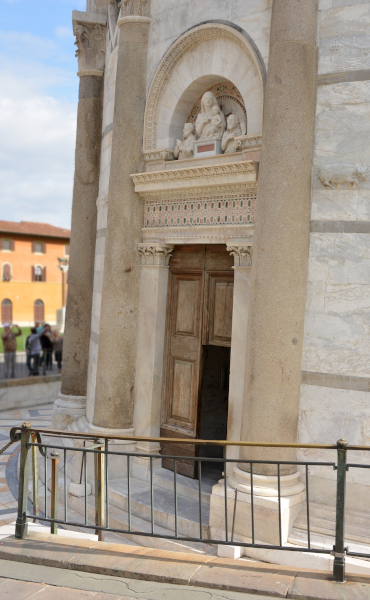
It is assumed that the tower stands on the boundary of different soil layers – a clay layer and a harbor basin that was already silted up at the time of construction and is no longer recognizable. As a result, part of the foundation sags more under the load – the tower leans. Through modern measurements it was also recognized that besides the inclination there was also a rotation. Since 1911, the movement of the tower has been continuously observed. In 1990, the inclination increased up to 5° and cracks appeared. As a result, the tower was locked. Lead bars were used to stop the inclination. Steel tires had to stabilize several floors. Later, steel cables were also installed. As of 1993, about 900 tons of lead were lying in bars on the northeast side of the tower, piles several meters high.
Extensive renovation and clearance
It was not until 1998 that the decision was made to carry out a fundamental remediation procedure by soil extraction. In this process, large amounts of soil were extracted by drilling on the higher northeast side. The leaning tower was straightened by 1.5 degrees or 40 cm. This corresponds roughly to the increase in inclination over the last 200 years. After stabilization of the foundation area and repair of the damage, the tower was reopened in 2001. It is expected that the restoration will have a stabilizing effect on the Leaning Tower for about 300 years. Since the reopening, visits to and inside the Leaning Tower have been possible. The tower can be climbed via the interior spiral staircase to the belfry. There is an all-round viewing platform accessible.
To visit the Leaning Tower and the Cathedral of Pisa, you can book a combination ticket online here* and switch to the fast lane at the entrance.
Pisa – from a maritime republic to a student city
The Italian city of Pisa is the capital of the province of the same name, Pisa, in Tuscany and is located near the mouth of the Arno River into the Ligurian Sea, a section of the Mediterranean Sea. Pisa has about 91,400 inhabitants.
Pisa even has its own regional language, Pisan, with its own script, which has partially survived to the present day.
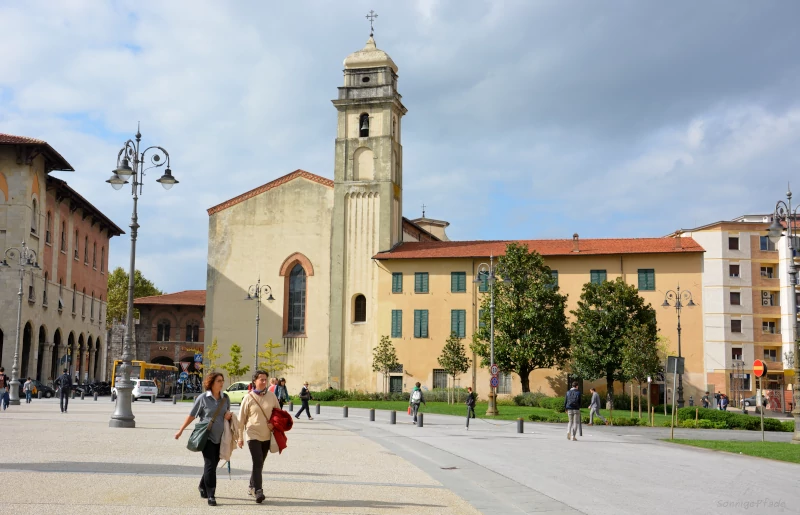
Wars, competition and defeats – Pisa in the shadow of powerful neighbors
Originally, Pisa, like so many European cities, was a Roman settlement. The remains of the terme romagne – Bagni di Nerone , a Roman wellness thermal bath on the northern city wall right next to the city gate Porta a Lucca still bear witness to this today.
Pisa was a city-state and one of the maritime republics in the Middle Ages. The port on the Arno and the extensive trading activities of Pisan merchant families ensured rapid development and widespread influence in the northern Mediterranean. But even with Pisa’s power in the region, things kept going wrong. There were constant disputes and wars over the offshore island of Elba, as well as over Corsica and Sardinia. The islands were long in the hands of Saracens, who were a constant threat to the port and shipping in the Ligurian Sea.
But political differences – Pisa was a city-state of the nobility, while Florence, for example, was a city-public of bourgeois merchants – and the struggle for influence and economic advantages between the city-states meant that Pisa was constantly threatened and had to endure prolonged wars and sieges. Besides Florence, the cities of Lucca and Genoa in particular were competitors, some of which formed alliances against Pisa. A city wall with towers and gates, which surrounds a large part of the old town quarters of Pisa, still bears witness to this period.
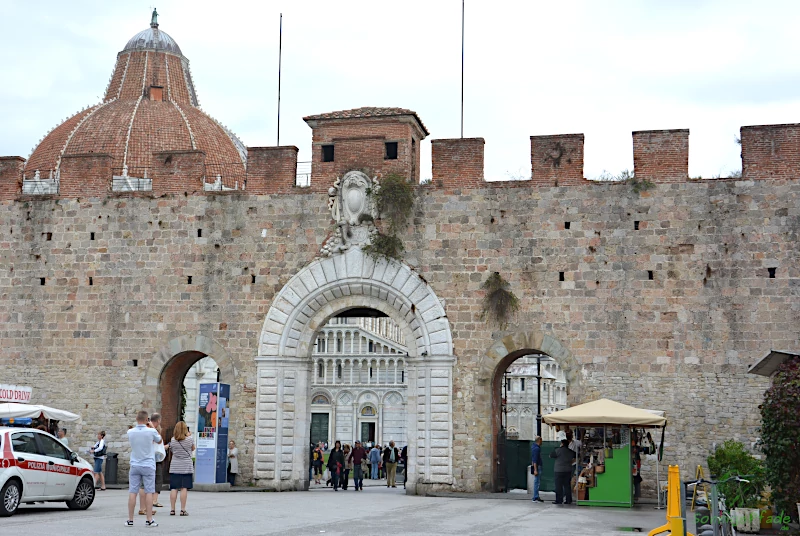
After all these battles and wars, Pisa finally lost its independence to Florence in 1406. Especially important for Florence was the unhindered free access to the port.
In 1409, the city was the scene of disputes within the European church at the Council of Pisa. Actually, these were supposed to be settled at the council, but that also went wrong. The Council of Pisa temporarily led to the rule of three competing popes – Pisa, Rome and Avignon were thereafter papal – seat.
Scholars and University – Pisa as a center of higher education
Despite all the defeats and losses in the struggle for regional supremacy, Pisa also has a high artistic-historical importance. The city is the home of the polymath Galileo Galilei and the medieval mathematician Leonardo da Pisa, known today mainly as Fibonacci. The latter was able to study the Indian-Arabic number system through stays in Algeria and other Arab countries and formulate his findings based on it. A personal monument among mathematicians is the Fibonacci – sequence named after him.
Especially under the rule of the Medici in Florence, Pisa was not completely written off as a troublesome competitor and province. The Medici tried to give Pisa its own role in some fields. Under Cosimo de Medici, Pisa’s university grew into a place of research and teaching, which to this day is of great importance to all of Italy and enjoys international recognition. In addition to the university, several colleges, including two of Italy’s elite universities, are located in Pisa. Among the inhabitants of Pisa, more than a third, about 40,000, are students, which is clearly reflected in the cityscape and in the social structure of the city.
Museums in Pisa
Besides the main attraction of Pisa, the Piazza dei Miracoli with the Leaning Tower, the Cathedral of Santa Maria Assunta, the Baptistery and the historic cemetery Camposanto Monumentale, there are several museums in the city for an interested public.
Directly in Piazza Duomo there is also the Museo dell’ Opera del Duomo. This is primarily the home of the cathedral treasury of the Pisan Cathedral of Santa Maria Assunta. There is also a sculpture collection with originals by Pisa masters. The museum’s cloister becomes the venue for classical music and jazz concerts from mid-June to early July each year.

Also in Piazza dei Miracoli, on the southern edge is the Museo delle Sinopie. The sinopias are sketches and designs for frescoes, mosaics or oil paintings. Natural pigments in ocher or reddish-brown iron oxide compounds were used as paint. The Museo in Piazza Duomo shows the designs for frescoes of the Camposanto Monumentale, practically vis á vis opposite.
Museo degli Strumenti di Calcolo – this museum near the Torre di Sant Agnese is dedicated to the ancestors of computers. It focuses on the history of computer science and data processing and displays, among other things, mechanical tools used by scientists, such as old calculating machines. This is particularly interesting, since Fibonacci also dealt scientifically with the abacus and other Arabic calculating tools.
Another museum that cannot be found everywhere is the Museo delle navi antiche di Pisa. Here, at excavation sites of Roman ships and Etruscan port facilities, about 30 shipwrecks, some still with cargo, have been processed. The museum is located in Via Ranuccio Bianchi Bandinelli.
[Contains *advertising!]
Travel tips for Pisa
Pisa is the capital of a province of the same name in the Tuscany region of central Italy. The city is located on the Arno River, a few kilometers before it flows into the Ligurian Sea in the Mediterranean Sea.
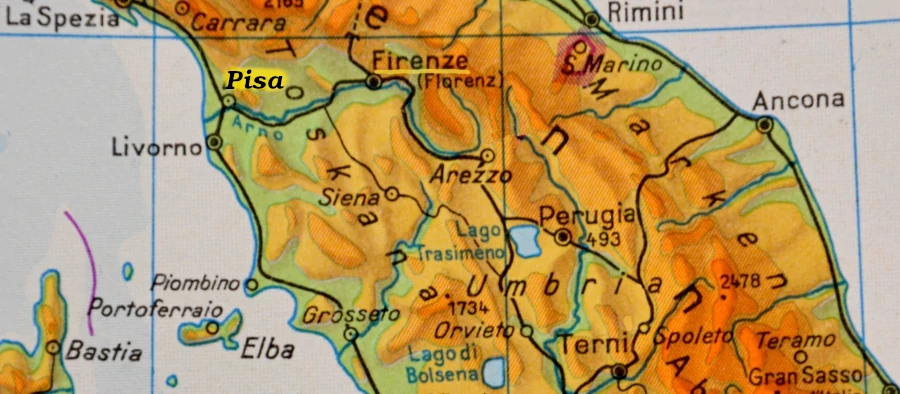
Arrival in Pisa
If you want to fly to the famous Italian region Tuscany, you can do it through Pisa International Airport. It is even more important than the airport of the Tuscan capital Florence. Pisa simply had more space for expansion and thus the better cards. The Pisa Airport is served from all over Europe, by major airlines such as brusselsairlines* (with partners) as well as by low-cost airlines such as easyjet*.
Pisa is easily reached by train* via Florence, the Tuscan capital. Trains between the two cities are frequent and fast, and the journey through the Tuscan countryside is also a short sightseeing tour of the region. The Pisa Centrale train station is located on the southern edge of the old town, not far from it also the Sesta Porta bus station. In addition to the main station Pisa Centrale with connections in all directions, Pisa San Rossore station is particularly interesting, which is located close to the main sights of Piazza dei Miracoli. From this station you can also quickly reach Lucca.
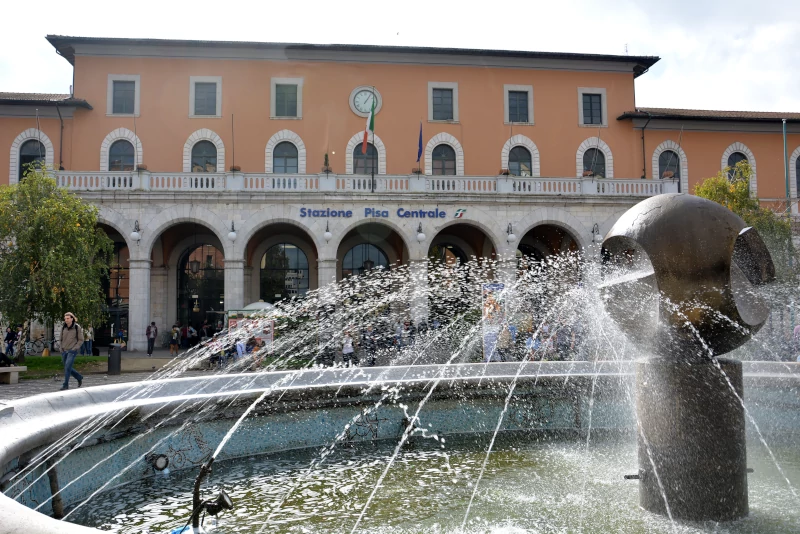
Florence is for Tuscany the key to the Italian high-speed rail network and to the connection with the Central European railroads of Switzerland, Germany and Austria. Florence is also the transfer point for long-distance bus* travel within Europe to Tuscany.
With your own car, rental car* or a camper van*, Pisa can be approached via the A12 highway that runs past to the west (from Turin, Genoa, Viareggio to Livorno and Rome). If you are coming from the north and want to go directly to the main sights of Pisa in the old part of the city, it is best to leave the A12 already from the Pisa – Nord exit. At the bus terminal there are large parking lots including spaces for camper van. From there it is only a few hundred meters to Piazza dei Miracoli. Other parking lots, also including Camper Van are northeast of the center on the road to Lucca.
Note absolutely – also in Pisa the city center is provided with strict entrance – restrictions for private vehicles. Camera-monitored each entrance into the “Zona a Traffico Limitato” is punished. It is therefore highly recommended to leave your car already parked in one of the visitor parking lots on the outskirts of the center.
Between Florence and Pisa there is an expressway SGC FI-PI-LI (Firenze – Pisa – Livorno), which tangents Pisa to the south and joins the A12 southwest of the city. This is the most convenient car connection from Florence to Pisa.
Weather in Pisa
Of course you can travel to Pisa all year round. However, from November to March, even in Tuscany, you have to expect cold, early darkness and increased rain. In contrast, it is usually pleasant from Easter to June or in September and October. In the summer months, Pisa is often overcrowded and there can be heat waves of up to 40°C, which make a stay in the city anything but pleasant.
The weather in Pisa today and the weather forecast for the next days.
Different ways to explore the city of Pisa
In Pisa there is not only the possibility to explore the sights individually on two recommended routes. City sightseeing tours are arranged by the Pisa Tourist Information about 100m north of the train station in Piazza Vittorio Emanuele. Online you can book a 2 hour guided tour of Pisa* (from the main train station) here.
In addition, as in many other cities, there are sightseeing buses in the form of double-decker buses with the Caprio roof open at the top. The buses leave from April to October from Piazza Aricivescovado behind the Museo dell’Opera del Duomo.
On your own, yet a bit brisker, you can do it with rental bikes. The bike rental Tuscany in Tour for individual city exploration in Pisa you will find in Via Ferdinando Capponi.
At Piazza dei Miracoli, horse-drawn carriages also await foot-lame city slickers to discover Pisa’s sights from the comfort of a bench.
Certainly not the right approach for all attractions, but boat tours on the Arno river are something different. These are offered on three different routes (lengths, one of them to the mouth through the natural park) also from April to October. A special highlight can be a Pisa by night – tour, which starts at 22:30 from the pier Scalo dei Ranaioli). This should be booked in advance (info@ ilnavicello.it).
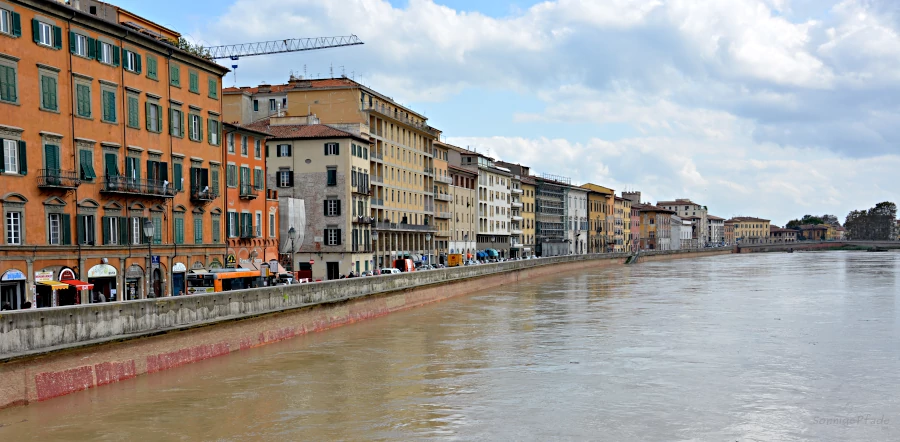
A trip within the trip? Day trip from Pisa to Cinque Terre
If you would like to get to know another special region on the Ligurian coast in comfort, then set off on a day trip by minibus to the Cinque Terre*. There, the picturesque colorful coastal villages await you between the cliffs of the steep coast. This day trip takes about 9 to 10 hours, so there is enough time to explore the villages individually.
Accommodation in Pisa
Many tourists come to Pisa just for one day. A few photos of and with the Leaning Tower, a short visit to the cathedral, a stroll through the city and the sights of Pisa are already done and checked off. But if you really don’t want to just make the famous checkmark on the „already seen“ list, you should devote a little more time to this Tuscan city. Even if the museum landscape in Pisa is by far not as lush as in Florence, the city with the most famous of all leaning towers has more to offer than just the Piazza dei Miracoli. What’s more, it’s easy to take a regional train from Pisa Centrale or Pisa San Rossore station to Lucca – another exciting city without having to change quarters. Therefore, here for Pisa a few accommodation – offers in different price ranges:
budget Pisa – hostels for the thrifty
How could it be otherwise, there is of course a hostel Pisa Tower* in the city. In this hostel with colorful interior design you can stay in dormitory – bed. But there are also a few private rooms for two or four people even with private bathroom. For some entertainment there is a billiards table and various games in an extra game room. It is only 200m to Piazza dei Miracoli.
Closer to the train station, for those traveling with large luggage, is the Safestay Pisa Hostel*. This makes the walk to Piazza dei Miracoli and the Leaning Tower of course a bit longer (ca.2km). At the same time you can explore other beautiful corners of Pisa. There is no common kitchen in this hostel (max. kettle and microwave for own supply), but a large common room and a garden. Accommodation is mainly in dormitories of various sizes, but there are also a few private rooms, some with private bathrooms.
Directly in the station area is the Pisa Trainstation Hostel*. The accommodation offers dormitory beds for 4 to 6 guests, as well as private double rooms on a small scale. There is a shared kitchen. However, for those who like to go on excursions and do not want to sacrifice time for their own preparation, the staff of the Pisa Trainstation Hostel can also provide you with a lunch – package for the road. Since the Cathedral and the Leaning Tower are located at the other end of the city center of Pisa, an extensive stroll through the city is a prerequisite for visiting them.
Middle class hotels in Pisa
At about 500m from Pisa’s main sights, the location of Hotel di Stefano* is very good. Still, guests are happy to have quiet rooms for the night. The rooftop terrace offers sweeping views of Pisa’s historic district. Room sizes range from single rooms to expandable quadruple rooms, so families can easily accommodate. Some rooms at Hotel di Stefano are handicapped accessible, and the upper floors can be reached by elevator. Pets are allowed.
Hotel Pisa Tower* is right there – just 100m from the famous Leaning Tower! Different rooms allow accommodation from single travelers to families. Even pets are allowed (after registration). Getting to and from the hotel should not be too difficult either, as there is a bus stop right in front of the Pisa Tower hotel, from where you can reach the train station and the airport.
The Residence Domus* has studios and apartments to offer to its guests. With a simple kitchen equipment in the apartment you are independent in your supply. The rooms have bathrooms with shower or bathtub. Pets are allowed on request and for an extra charge. Residence Domus is about 1.5 km from Piazza dei Miracoli and the Leaning Tower of Pisa.
Pisa Hotels at their best
In an old, carefully restored townhouse in Pisa is ****Hotel Bologna*. It’s easy to reach from the train station and is close to Pisa’s historic center. All rooms have coffee and tea facilities. Access to the Hotel Bologna is wheelchair accessible. There are also family rooms. Bicycles can be rented for a fee. Free Tuscan specialties are served for tasting at the bar in the evenings. This hotel has parking, which can be used at an additional cost.
The ****Villa Tower Inn* is one of the most popular hotels in Pisa. This is due not only to its ideal location about a 3-minute walk from the Leaning Tower and 5 minutes from the Pisa S.Rossore train station, but also to the coziness in the rooms and throughout the hotel, as well as the friendly, helpful staff. Several rooms at Villa Tower Inn are family-friendly, and there are also appropriately equipped rooms for disabled guests. Child care is even available for a fee. Pets are allowed. Parking is available at the hotel.
For those who prefer a modern hotel for the nights, the *****Pisa Tower Plaza is a good choice. Among the amenities that the city center houses in old villas cannot offer is the outdoor – pool (seasonal). A fitness center can also be used indoors. The Pisa Tower Plaza Hotel has mainly double and triple rooms, some of which can be upgraded to family rooms. Baby and child care is available for a fee. It’s about 1.5km to the Leaning Tower. Pets are allowed. Parking at the hotel is fee-based, but possible.
Not on the leaning track, just on the Leaning Tower!
If you liked the article and would like to invite your friends to the Leaning Tower, share the link to the post on your social media channels. A positive response on the web encourages content worth reading and helps search engines weed out the garbage. Thanks a lot!
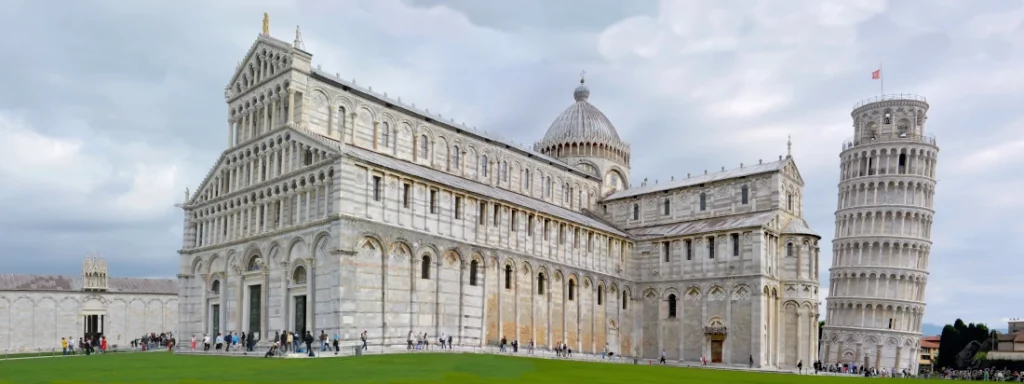
Note on * advertising links
Some links in the article are marked with *. These are advertising links that lead to a store, an agency or similar. If you follow the link and book something, “sunny trails” blog gets a small commission, which is used to pay the expenses for the operation of this blog. Nothing will be more expensive for you, because the commission is already taken into account in the pricing.



